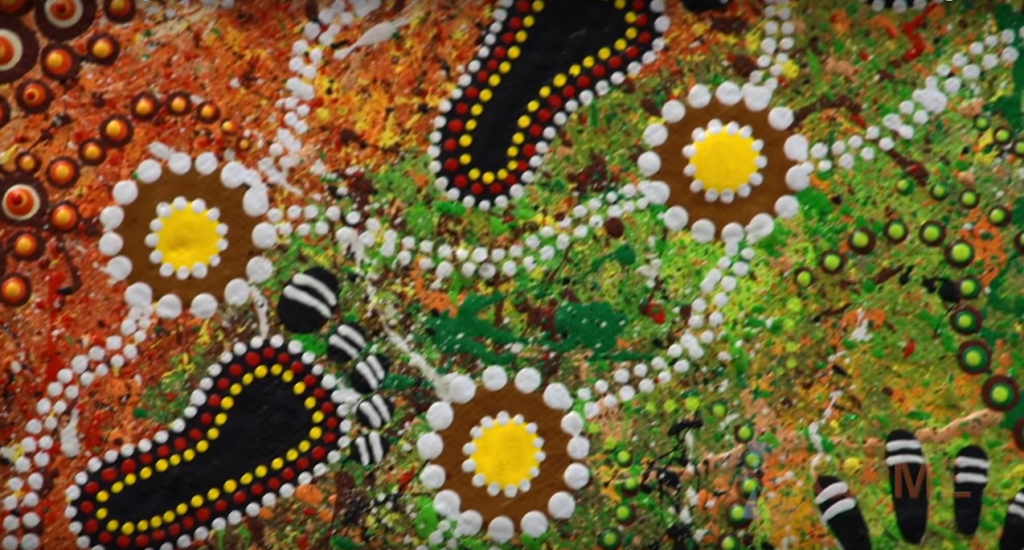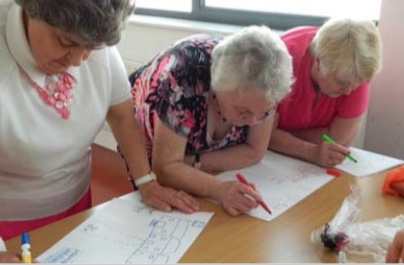Co-production rule #6
Be human
It’s 6.10pm on a cold January evening…
The kettles are filled, the water boiler is heating, the projector is working, the Powerpoint has been triple-checked… more about this on the next page. You’ve put the chairs out. Get used to the idea of moving chairs, you will do a lot of this, but please follow your organisation’s Manual Handling guidelines. You’ve remembered everything because you made a list, including asking for the heating to be switched on in the hall. Your pop-up stand is displayed, with all the appropriate logos. And you brought some maps with you, mounted on corriboard. No?
If you are able to get your hands on large-format, printed maps of the place you’re working in, you’ll find the community drawn to them more than a hundred PowerPoint slides. I mentioned earlier about the Ordnance Survey maps of Ireland and thanks to Daragh McDonough in Donegal County Council’s mapping section, we were able to display three maps of Inch at our first meeting on the island.
It’s 6.52pm on a cold January evening…
The gatekeepers have been chatting to their friends and neighbours, the community Facebook page posted the invitation two weeks ago, the parish magazine/newsletter was handed out last Sunday. The internet connection is working, even if you’ve had to improvise. The tea and coffee is ready, and there are some really nice chocolate biscuits which you are desperately trying to resist eating.

And then, magically, in twos and threes, the community arrive. They’re here to hear about this co-production project. They’re here because they’re interested. They’re here because you sparked some curiosity. They’re here because you’ve spent the last month knocking on doors. They’re here because you’ve done everything you can to make sure the information was available as widely as possible. They’re here because you’ve done your job.
What they are not here for…
Your professional qualifications, academic achievements, essays and articles, no matter how impressive.
To be bored, or worse, to be patronised
You are about to stand up and talk to a group of people who are there voluntarily. They are the potential curators, makes and storytellers. They are more than just equal partners, in this co-production, they are people whose lives, experiences and interests will inform the outputs of the project. They don’t really care how many letters you have after you name, but they do care about their community, its history, its heritage and its people. Remind yourself, this is not your project, this is their project. It’s not about you.
Say hello to people, welcome them, chat to them as they’re coming through the door. Talk about the weather. Tell them how lovely their hall is. Ask them where they’re from. Be specific. In Ireland, counties are divided into parishes, parishes into townlands. Inch has 7 townlands: Glack or Bohullion, Carnaghan, Bayelt, Castlequarter, Carrickanee, Moress, Grange and Ballynakilly. Ask them did they travel far. Be human.
It’s 7.02pm on a cold January evening…
“How are you doing everybody. Thanks for coming out on such a miserable evening. We’ll start in a couple of minutes, but if anybody hasn’t got a cup of tea…”
Remember, you are an actor now
You’ll need to work on your voice projection. There’s no point in mumbling. And don’t hide behind a microphone. People need to have connection with you. Yes, I’m lucky. I’ve spent most of my career working in the theatre industry. Projecting our voice is part of what we do. If you’re not used to talking to large groups of people, then you’ll need to work on it. There are plenty of resources on the internet to help you with this. It’s skill you’re going to need. You’ll also need to work on your self-confidence if you’re a little shy or introverted. That is something I’ve had to overcome. I did that with my game face, and a lot of practice. Use your hands, smile, project, be confident. Be human.
It’s 7.08pm on a cold January evening…
Say hello to the gatekeepers. Not all of them could make it, but hopefully some of them will be there, and they’re sitting with friends who they will introduce. Say hello. Try and remember the names. Be human.
It’s 7.13pm on a cold January evening…
“Good evening, ladies and gentlemen, thank you so much for coming down here this evening. My name is Guy and I’m here tonight to tell you a little about the CINE Project and what we’d love to be able to make with you, the community of the beautiful island of Inch…”
Compliments, if they’re sincere will take you long way. A little charm and humour will take you a long way. Inhabit the role of a confident, approachable, interesting and interested human being. And then, when you see those first smiles from your audience, it’s time to direct the show. For that, you’re going to need a damn good presentation.
Perspectives VII
I’ve mentioned maps a few times. In my own mind, our first marks on the land were lines and circles, scrawled into the sand, or daubed onto the walls of a cave. We made maps to navigate our way around our world, to delineate our place from another, to find the herds and to remember the location of drinking water.

Australian Aboriginal art is often representative of the land, seen from above, where trees are circles and lines are tribal or linguistic boundaries, rivers and creek beds. Maps seem to trigger unconscious and profound responses in all of us. Maybe there is something about them that connects us to our past and our distant ancestors, or maybe it’s just a need to know where we are. One of the most interesting and fruitful activities in my own oral history practice is the making of maps, and the naming of houses, fields and landscapes.

During the Sense of Memory project, I had the delight of working with a group of women from Strabane, in County Tyrone. One of the sessions I facilitated was making maps of the place they lived when they were a child. For most, the exercise was easy, and an enjoyable way of reminiscing about their young lives and their families. One woman, Elsie, sat in the corner with a blank sheet of paper, looking lost. I asked her what was wrong, and she said, ‘I just can’t remember anything.’ At that point a red flag went up. I wondered if there might be some childhood trauma or sadness. I skirted around the edges a little, and she laughed. ‘No, nothing like that. I just can’t remember.’ I asked her about the cottage. What colour was the door? How many windows? Nothing. Elsie was a blank. ‘Do you remember anything in the garden?’
Elsie’s eyes lit up. ‘There were walnut trees. Two walnut trees, and one is still there.’ Ten minutes later, Elsie’s piece of paper was filled with her entire childhood.
Maps connect us intellectually, physically and spiritually with a place. They are wired into us, like nothing else. If your interest is history, heritage, oral history, theatre, art, or whatever else, maps will lead you to the heart of a community. Maps allow us all to declare…
Here I am. This is where I live. This is where I do be1.
1 Irish English, also called Hiberno-English, can express habitual aspect in present tense by enlisting Irish (Gaelic) grammar. In Irish, tá mé (which can contract to táim) means ‘I am’, literally ‘is me’. But bíonn mé (→ bím) means ‘I (habitually) am’ – a different sense of be. The distinction is so intrinsic to Irish that our ancestors refashioned English to incorporate it.
Stan Carey’s Sentence First Blog



